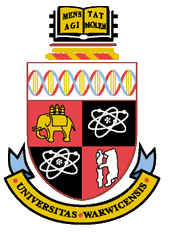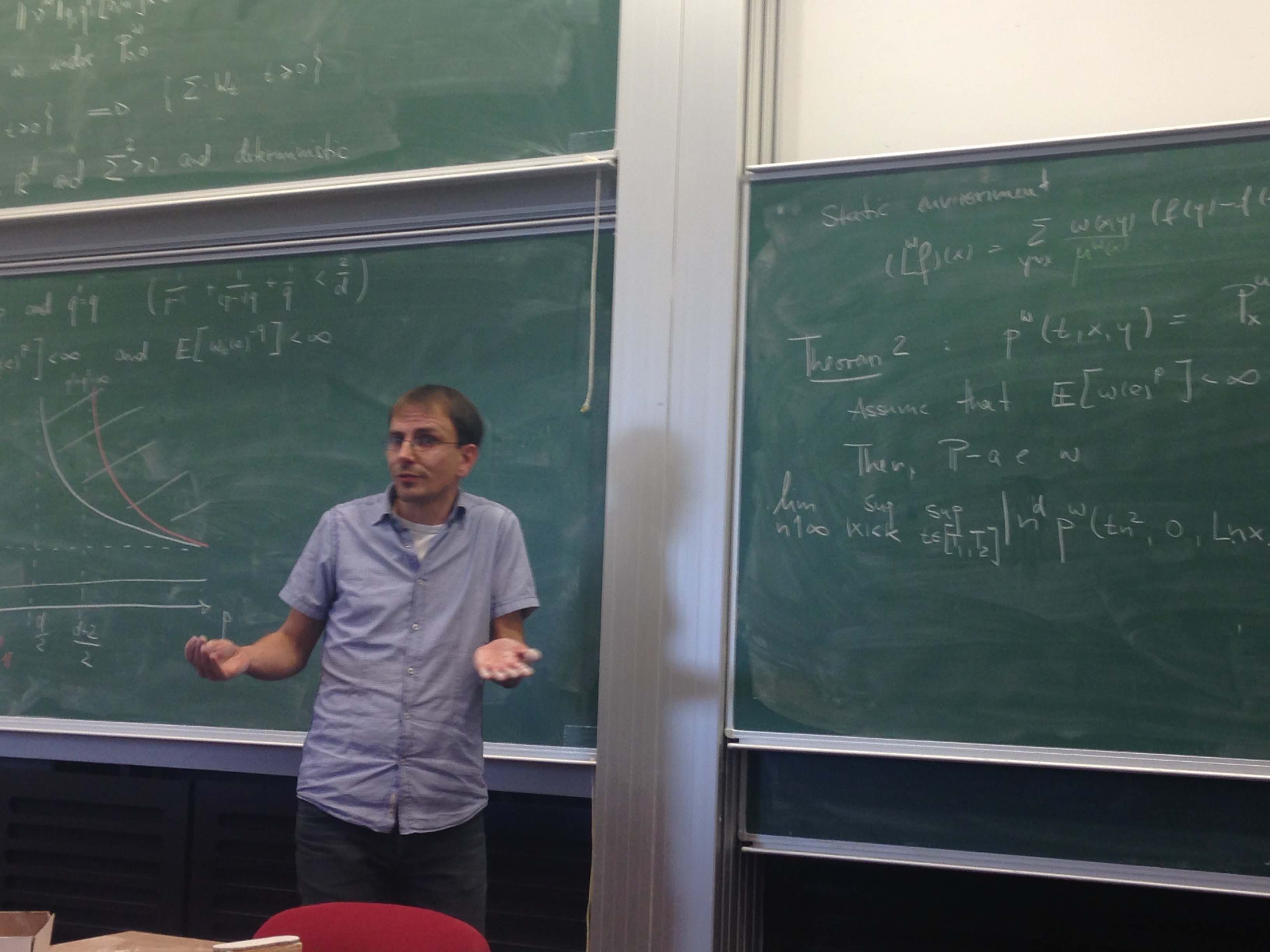Warwick Statistical Mechanics Seminar
in the Department of Mathematics
 |
This term, all seminars take place Thursdays at 2pm, room MS.04 (Zeeman Building), unless indicated otherwise. |
 Martin Slowik, 22.10.2015 |
| 12.01.2017 | |
| 19.01.2017 | Nils Berglund (Université d`Orléans) A "thermodynamic" characterisation of some regularity structures near the subcriticality threshold We are interested in nonlinear stochastic partial differential equations with fractional Laplacian of order rho in (0,2) and driven by space-time white noise. Martin Hairer`s theory of regularity structures can be applied to these equations when they are locally subcritical, which requires rho to be larger than a critical value depending on the space dimension and the order of the nonlinear term. As rho approaches its critical value from above, the size of the negative-homogeneous sector of the model space diverges in a specific way, which can be determined by counting decorated rooted trees satisfying a number of constraints. We use thermodynamic concepts such as (relative) entropy to characterise the exponential growth of the number of trees and their degree distribution. This is joint work with Christian Kuehn (TU Munich). Here is a link to scanned notes: http://www.univ-orleans.fr/mapmo/membres/berglund/warwick17.pdf |
| 26.01.2017 | Ben Wallace (UBC Vancouver) Finite-order correlation length of the $|varphi|^4$ spin model in four dimensions The correlation length of order p for the $|varphi|^4$ spin model (a continuous-spin version of the O(n) model) is a normalization of the p-th moment of its two-point function. We will outline the proof (based on a renormalisation group method of Bauerschmidt, Brydges, and Slade) that, in the upper-critical dimension 4, the correlation length of order p undergoes mean-field scaling with a logarithmic correction as the critical point for this model is approached from above (for sufficiently weak coupling). Via a supersymmetric integral representation, this result also extends to the weakly self-avoiding walk with a contact attraction, for which the correlation length of order p is closely related to the mean p-th displacement of the walk. This is joint work with Roland Bauerschmidt, Gordon Slade, and Alexandre Tomberg. |
| 02.02.2017 | Jonas Lampart (Université de Bourgogne) A RAGE theorem for many-body systems The RAGE theorem establishes a connection between the spectrum of a self-adjoint operator H and the long-time behaviour of the dynamics it generates. In particular, for every initial condition the ergodic mean converges (weakly) to an element of the space spanned by the eigenvectors of H. I will present a refined version of this result for N-body Hamiltonians that also describes subsystems with n < N particles. This is joint work with Mathieu Lewin. |
| 09.02.2017 | Vladimir Rittenberg (University of Bonn) Correlation functions in conformal invariant stochastic processes We consider the problem of correlation functions in the stationary states of one-dimensional stochastic models having conformal invariance. If one considers the space dependence of the correlators, the novel aspect is that although one considers systems with periodic boundary conditions, the observables are described by boundary operators. From our experience with equilibrium problems one would have expected bulk operators. Boundary operators have correlators having critical exponents being half of those of bulk operators. If one studies the space-time dependence of the two-point function, one has to consider one boundary and one bulk operators. The Raise and Peel model has conformal invariance as can be shown in the spin 1/2 basis of the Hamiltonian which gives the time evolution of the system. This is an XXZ quantum chain with twisted boundary condition and local interactions. This Hamiltonian is integrable and the spectrum is known in the finite-size scaling limit. In the stochastic base in which the process is defined, the Hamiltonian is not local anymore. The mapping into an SOS model, helps to define new local operators. As a byproduct some new properties of the SOS model are conjectured. The predictions of conformal invariance are discussed in the new framework and compared with Monte Carlo simulations. |
| 16.02.2017 | Jean Bricmont (Université de Louvain) Random walks in Random environments We shall review how Renormalization Group methods can be used to study the long time behavior of random walks in random environments. |
| 23.02.2017 | Patrik Ferrari (University of Bonn) Anisotropic (2+1)-d growth and Gaussian limits of q-Whittaker processes We consider a discrete model for anisotropic (2+1)-dimensional growth of an interface height function. Owing to a connection with q-Whittaker functions, this system enjoys many explicit integral formulas. By considering a certain limit, we obtain a Gaussian process and determine its space-time covariance. We see the phenomenon of slow-decorrelation along characteristic directions. and if we look on a smaller spatial scale we obtain a space-time limit to the (2+1)-dimensional additive stochastic heat equation (or Edwards Wilkinson equation) along characteristic directions. In particular, the bulk height function converges to a Gaussian free field which evolves according to this stochastic PDE. |
| 02.03.2017 | |
| 09.03.2017 | Chiara Saffirio (University of Zürich) Mean field evolution of fermions with Coulomb interaction We will consider the many-body evolution of initially confined fermions in a joint mean-field and semiclassical scaling, focusing on the case of Coulomb interaction. We will show that, for initial states close to Slater determinants and under some conditions on the solution of the time-dependent Hatree-Fock equation, the many-body evolution converges towards the Hartree-Fock dynamics. This is a joint work with M. Porta, S. Rademacher and B. Schlein. |
| 16.03.2017 | |